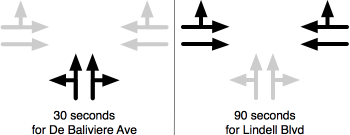Often times, it seems traffic engineers pay no attention to the needs of pedestrians at intersections. For example, earlier today, Urban Review STL wrote about the inadequacy of pedestrian signals downtown where pedestrian signals are either missing, inoperable, or just poorly timed.
Focusing on one aspect of poorly timed pedestrian signals, I’ve noticed many intersections where pedestrians are given short shrift: the steady “Don’t Walk” hand appears well before it is unsafe to cross the street.
The poorly timed pedestrian countdown timer is an easy example to spot. The countdown timer serves to inform pedestrians how much time remains to cross the street; indirectly, it also informs drivers how much time remains before the traffic signal turns red. When poorly timed, the countdown timer reaches zero well before the associated traffic signal turns red.
Twenty-five out of Ninety
As an example, let’s take a look at the intersection of Lindell Blvd with northbound De Baliviere Ave. At this intersection, a high volume of pedestrians cross De Baliviere Ave on the Forest Park trail. The diagram below shows the approximate signal timing for vehicles at this intersection.

Given the characteristics and signal timing for this intersection, it should stand to reason that the Forest Park trail users should get 90 seconds to cross De Baliviere Ave during which time vehicles on De Baliviere Ave have a red light. Currently, however, the “Walk” or flashing “Don’t Walk” signals are illuminated for only 25 seconds out of the 90 second green-time given to Lindell Blvd vehicles.
Needless to say, Forest Park trail users completely ignore the pedestrian signals and use the traffic signals, instead, as a guide of when to cross the street safely.
Complaint filed with the city’s Citizens’ Service Bureau.
